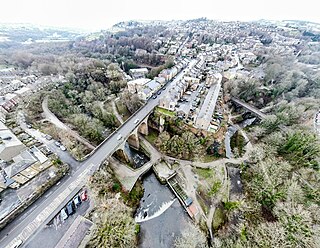
New Mills is a town in the Borough of High Peak, Derbyshire, England, 8 miles (13 km) south-east of Stockport and 13 miles (21 km) from Manchester at the confluence of the River Goyt and Sett. It is close to the border with Cheshire and above the Torrs, a 70 feet (21 m) deep gorge cut through carboniferous sandstone, on the north-western edge of the Peak District national park.

Whaley Bridge is a town and civil parish in the High Peak district of Derbyshire, England. It is situated on the River Goyt, 16 miles (26 km) south-east of Manchester, 7 miles (11 km) north of Buxton, 9 miles (14 km) north-east of Macclesfield and 28 miles (45 km) west of Sheffield. It had a population of 6,455 at the 2011 census, including Furness Vale, Horwich End, Bridgemont, Fernilee, Stoneheads and Taxal.
Peak Rail is a preserved railway in Derbyshire, England, which operates a steam and heritage diesel service for tourists and visitors to both the Peak District and the Derbyshire Dales.

Chinley is a rural village in the High Peak Borough of Derbyshire, England, with a population of 2,796 at the 2011 Census. Most of the civil parish is within the Peak District National Park. Historically, before the coming of the railway, the area was economically dominated by agriculture. Nowadays most inhabitants commute out of the village to work; accessible centres of work include Stockport, Sheffield and Manchester.

The Peak Forest Canal is a narrow locked artificial waterway in northern England. It is 14.8 miles (23.8 km) long and forms part of the connected English/Welsh inland waterway network.

Peak Forest is a small village and civil parish on the main road the (A623) from Chapel-en-le-Frith to Chesterfield in Derbyshire. The population of the civil parish at the 2011 census was 335.

Chapel Milton is a hamlet on the outskirts of Chapel-en-le-Frith on the road leading from there to Chinley and to Glossop. Within the parish of Chinley, Buxworth and Brownside, it takes its name from the site of a medieval corn mill, Maynstonfield Mill, or “Mainstonefield alias Chinley”. This mill was erected near a stream called Hockholme Brook, which is no longer marked though is thought to converge with the Black Brook at Chapel Milton. Originally built in 1391 for £12 4s 1d, the mill was demolished in 1946.
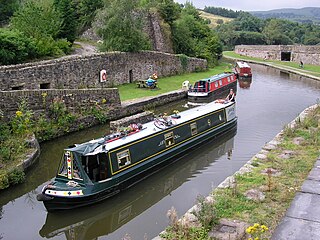
Bugsworth Basin is a canal basin at the terminus of the Peak Forest Canal at Buxworth in the valley of the Black Brook, close to Whaley Bridge. It was once a busy interchange with the Peak Forest Tramway, for the transport of limestone and burnt lime.
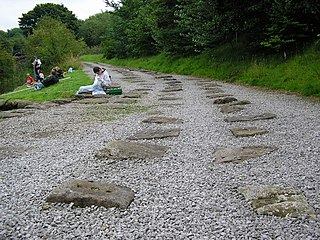
The Peak Forest Tramway was an early horse- and gravity-powered industrial railway system in Derbyshire, England. Opened for trade on 31 August 1796, it remained in operation until the 1920s. Much of the route and the structures associated with the line remain. The western section of the line is now the route of the Peak Forest Tramway Trail.
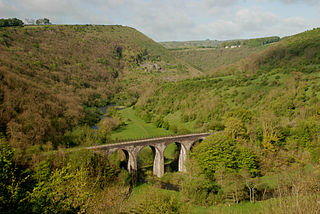
The Manchester, Buxton, Matlock and Midland Junction Railway ran from a junction with the Midland Railway at Ambergate to Rowsley north of Matlock and thence to Buxton.
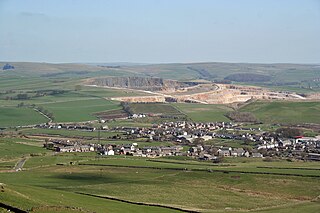
Dove Holes is a village in the High Peak district of Derbyshire, England. It has a population of about 1,200 (2001), shown in the 2011 Census as being included in the population of Chapel-en-le-Frith. It straddles the A6 road approximately three miles north of Buxton and three miles south of Chapel-en-le-Frith. Trains run from Dove Holes railway station into Manchester.

Chinley railway station serves the village of Chinley in Derbyshire, England. The station is 17+1⁄2 miles (28.2 km) south east of Manchester Piccadilly, on the Hope Valley Line from Sheffield to Manchester. It is unstaffed and is managed by Northern Trains.
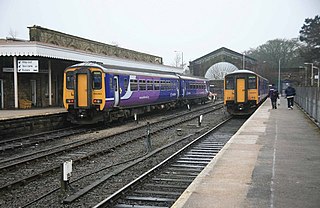
Buxton railway station serves the Peak District town of Buxton in Derbyshire, England. It is managed and served by Northern. The station is 25+3⁄4 miles (41.4 km) south east of Manchester Piccadilly and is the terminus of the Buxton Line.

Dove Holes railway station serves the village of Dove Holes, Derbyshire, England. The station is on the Buxton line between Manchester Piccadilly and Buxton; it is situated 22+3⁄4 miles (36.6 km) south-east of Piccadilly. It is managed and served by Northern Trains.

Whaley Bridge railway station serves the Peak District town of Whaley Bridge in Derbyshire, England. The station is on the Manchester-Buxton Line 16+1⁄4 miles (26.2 km) south east of Manchester Piccadilly.
The Stockport, Disley and Whaley Bridge Railway was an early railway company in England which was opened in 1857 between Stockport Edgeley and Whaley Bridge.

New Smithy is a hamlet in the civil parish of Chinley, Buxworth and Brownside, Derbyshire, England, near the village of Chinley. It sits on the A624 trunk road from Glossop to Chapel-en-le-Frith featuring a TOTSO where left carries one down to Chapel and right heads to Chinley. There is a railway bridge over the turning, used for both freight and passengers, on the Hope Valley Line to Sheffield and Manchester; very close down the line is Chinley railway station. Next to this the Crown & Mitre pub, now converted into residential flats, is the main landmark and there are a couple of residential housing streets and terraces, and one or two businesses.

Chinley, Buxworth and Brownside is a civil parish within the High Peak district, which is in the county of Derbyshire, England. Partially rural with several villages contained within, its population was 2,796 residents in the 2011 census. The parish is 150 miles (240 km) north west of London, 35 miles (56 km) north west of the county city of Derby, and 1+1⁄3 miles (2.1 km) north of the nearest market town of Chapel-en-le-Frith. Being on the edge of the county border, it shares a boundary with the parishes of Chapel-en-le-Frith, Edale, Hayfield, New Mills and Whaley Bridge. A substantial portion of the parish is within the Peak District national park.

Chapel Milton Viaduct is a Grade II listed bifurcated railway viaduct on the Great Rocks Line at its junction with the Hope Valley Line, straddling the Black Brook valley in Chapel Milton, Derbyshire, England. The first section of the viaduct, built by the Midland Railway in 1867, diverges and curves to the west while the second, built in 1890, curves to the east as the line, coming up from the south, links up with the main line between Sheffield and Manchester.
Chinley, Buxworth and Brownside is a civil parish in the High Peak district of Derbyshire, England. The parish contains 29 listed buildings that are recorded in the National Heritage List for England. Of these, one is listed at Grade II*, the middle of the three grades, and the others are at Grade II, the lowest grade. The parish contains settlements, including the villages of Chinley and Buxworth, and is otherwise rural. Most of the listed buildings are farmhouses and farm buildings, houses, cottages and associated structures. The Peak Forest Canal ends in the parish at Bugsworth Basin, and two listed buildings are associated with it. The other listed buildings consist of a church and two chapels, and a pair of railway viaducts.



















